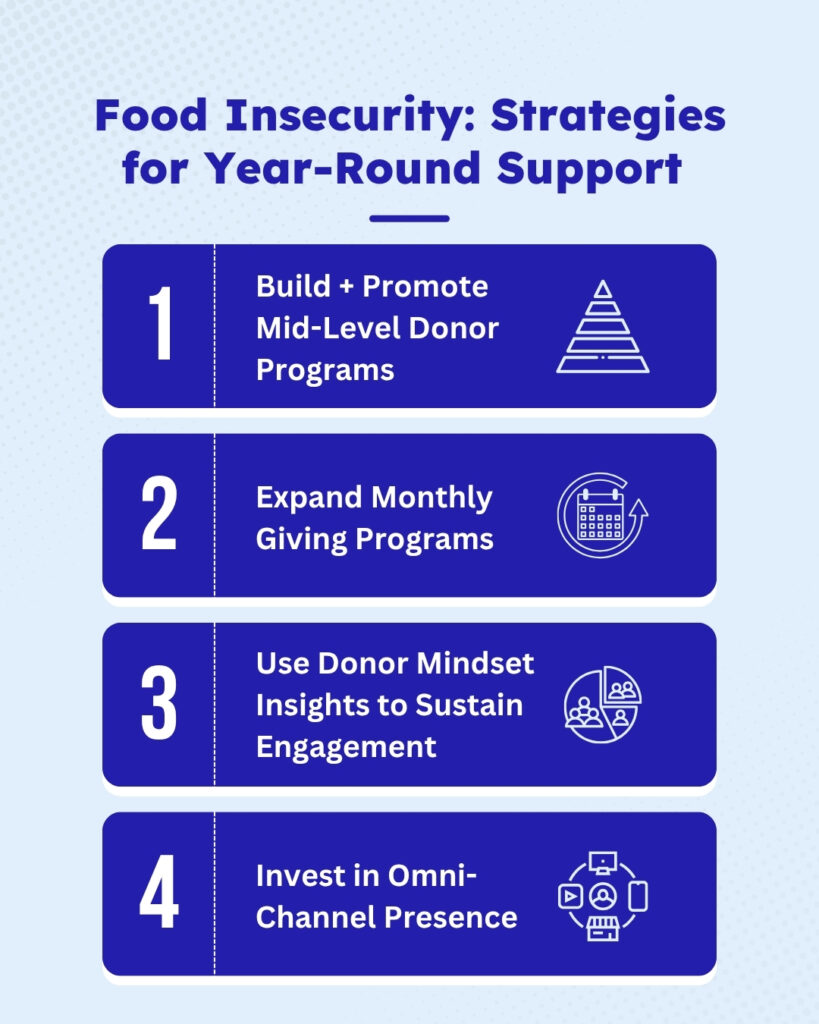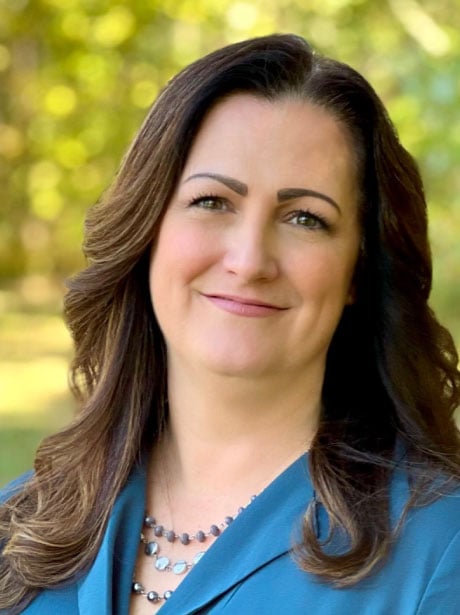Beyond the Holiday Rush: How Food Banks Can Build Year-Round Giving Strength

Each year, the holidays bring a surge of generosity for food banks. But hunger isn’t seasonal. Annually, more than 47 million Americans rely on food assistance, according to Feeding America, a sharp increase from pre-pandemic levels. Meanwhile, 14.3% of U.S. households experienced food insecurity, up from just 10.2% in 2021.
Yet, despite this growing need, donations to food banks have largely plateaued. While overall U.S. charitable giving rose 6.3% in 2024, contributions to hunger relief organizations remained relatively flat. That disconnect between rising demand and stalled donations is one of the most pressing challenges facing food banks today.
The gap reveals a fundamental truth: food banks cannot afford to rely on seasonal generosity. To thrive, food banks must build sustainable, year-round support.
The Problem: Overreliance on Episodic Giving
Food banks, perhaps more than any other nonprofit type, experience the ebbs and flows of donor attention. Many see as much as 40% of their annual revenue concentrated in the final quarter, driven by holiday campaigns, year-end tax planning, and seasonal corporate partnerships.
While these surges are vital, they mask underlying vulnerabilities:
- Donor fatigue: Donors increasingly report feeling overwhelmed by repeated appeals during peak giving seasons, and engagement often wanes by spring.
- Decline in new donor acquisition: As acquisition slows, relying on bursts of first-time gifts is no longer sustainable. Organizations often find it challenging to attract new donors during the rest of the year.
- Overdependence on large gifts: Corporate and institutional donors provide critical stability, but their dominance in food bank budgets underscores the fragility of sustained engagement. These gifts may make a great headline but are a poor substitute for steady, diversified revenue.
The result is a cycle of highs and lows, with fundraising peaking in December followed by lean months that strain food banks’ ability to serve communities consistently. Hunger isn’t seasonal.
The Cost of Inconsistency
This uneven revenue pattern comes with real costs, especially as many food banks operate on tight budgets and limited staff. The result?
- Strained operations. Food procurement and distribution require long-term planning, but revenue spikes and drop-offs make it difficult to forecast inventory, invest in technology or plan for the future.
- Interrupted services. Individuals and families need consistent access to food year-round. Funding gaps risk interruptions that hit hardest in non-peak seasons, such as summer.
- Staff and volunteer pressure. The feast-or-famine cycle of Q4 intensity followed by quieter quarters creates burnout and inefficiencies.
Ultimately, inconsistent funding can undermine hunger relief efforts. As the need grows steadily, fundraising strategies must match that pace.
Strategies for Year-Round Support
The good news is that food banks are uniquely positioned to deepen community connections and inspire consistent giving. By moving beyond an episodic fundraising model, they can create sustainable donor pipelines. Here are four strategies to start:

1. Build and Promote Mid-Level Donor Programs
Too often, food banks focus on entry-level donors or chase major gifts. But the middle is where the greatest growth potential lies. Mid-level donors (often those giving $500–$5,000 annually) crave deeper engagement than mass appeals but don’t yet belong to the major donor tier.
Cultivating this group through personalized stewardship, impact updates, and insider access (like virtual tours or small-group conversations with staff) builds loyalty and moves them toward higher giving.
2. Expand Monthly Giving Programs
Recurring donors are the antidote to volatility. Monthly giving programs turn episodic support into predictable revenue that smooths cash flow throughout the year.
For food banks, this is a natural fit: donors can easily connect a monthly gift to tangible outcomes ($25 a month feeds a family of four). Investing in user-friendly digital sign-ups, automatic renewal, and branded recurring programs can accelerate growth.
The Giving Outlook unpacks the trends shaping philanthropy and what they mean for your mission.
3. Use Donor Mindset Insights to Sustain Engagement
Food insecurity spikes during crises such as pandemics, natural disasters, and economic downturns. But donors’ compassion shouldn’t fade when the emergency ends.
Using mindset segmentation – the understanding of a donor’s capacity and motivation —helps keep donors engaged between emergencies. Donors motivated by fairness may respond to stories about childhood hunger, while those motivated by efficiency may be inspired by metrics showing cost-per-meal impact. Matching message to mindset builds longer-lasting connections.
4. Invest in Omni-channel Presence
Donors engage across platforms: email, text, direct mail, social media, and increasingly, peer-to-peer campaigns. Food banks that invest in an integrated, omni-channel presence stay top-of-mind year-round, not just during holiday campaigns.
Remember, consistency is key. Even light-touch, non-fundraising communications such as recipes, stories from families served, or behind-the-scenes warehouse updates can reinforce awareness and deepen trust.
A Call for Balance
Heading into 2026, food banks need to take on the growing imbalance in giving by building stronger mid-level and monthly donor programs, improving retention, and shifting from short-term fundraising pushes to more consistent, long-term engagement in an omni-channel fashion. Food insecurity isn’t a temporary issue — and our fundraising strategies shouldn’t be either.
This insight underscores what many leaders already know: episodic giving is not enough to meet the ongoing reality of hunger in America. The path forward lies in cultivating balance with a solid foundation of recurring and mid-level donors complemented by the essential support of major gifts and seasonal campaigns.
Building Sustainable Strength
With food insecurity on the rise and donations failing to keep pace, food banks must rethink the way they engage donors. The challenge is not just raising money — it’s raising it in a way that provides stability, predictability, and resilience.
At AGP, we work with food banks nationwide to design strategies that build balanced, sustainable donor portfolios. From developing mid-level pipelines to scaling monthly giving and leveraging donor mindset insights, our approach helps organizations move beyond the holiday rush to year-round strength.
Download the full Giving Outlook for Food Banks to dive deeper into the data and strategies shaping the future of hunger relief fundraising.
Ready to take the next step? Schedule a meeting with our food insecurity experts.

About Liz Lowe, VP, Client Relationships
Liz has over 20 years of fundraising, data management/processing, data analytics, production, digital, design, and media brokerage experience. With a heart founded in data, her primary goal is to find new ways to look at and use your data to inform strategy. She is highly skilled at utilizing a data-driven strategy to increase the response to your impactful direct response campaigns.
With experience on both the agency and production side of direct response campaigns, Liz has worked with a diverse portfolio of clients. In her current Client Relations role, Liz has followed her personal passion for making food accessible to everyone by leading the Food Bank and Human Services vertical at AGP. She brings her data-focused strategies to her clients to maximize the impact they can make in their communities to help those facing food insecurity and other barriers.